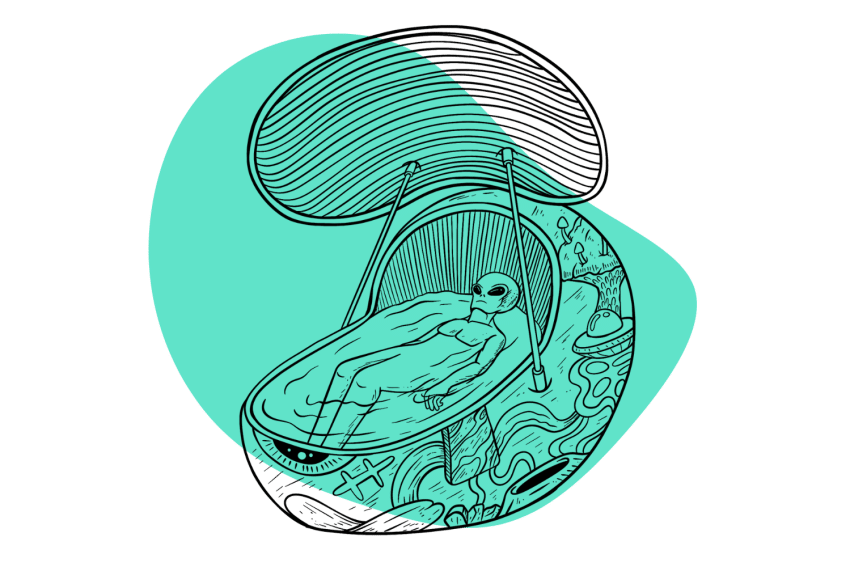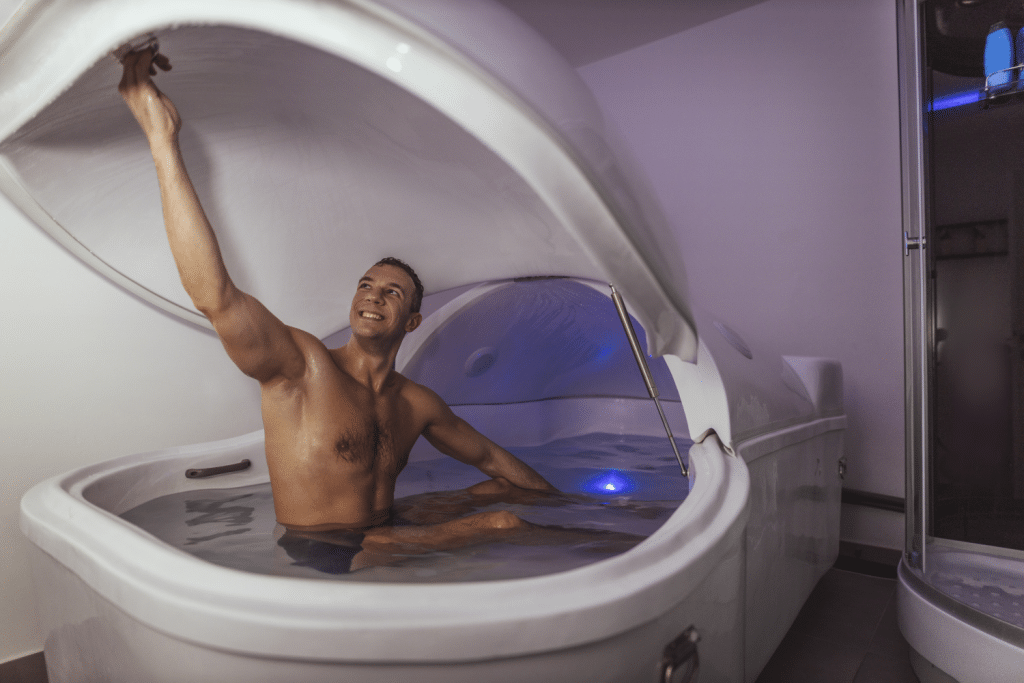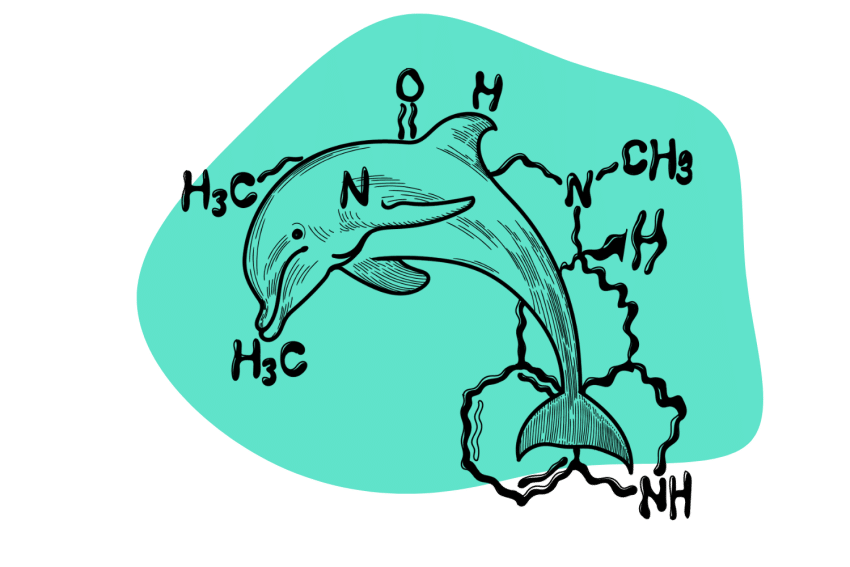Senseless Sanctuary: The Therapeutic Benefits of Sensory Deprivation Tanks
Sensory deprivation tanks (AKA float tanks) are soundproof and lightproof tanks filled with skin-temperature salty water that allows users to float effortlessly. This combination blocks out most of our sensory perception — allowing for a completely distraction-free environment to be with your thoughts.

Our culture is more stressed than ever. As a result, there’s a huge demand for mental health support these days.
That demand is coming with a plot twist: forget the pills from big pharma; Enter stage left eclectic technologies and modern alternative medicine.
We don’t want happy pills. We want tools that offer real therapeutic benefits for mind, body, and spirit. We want to soak in a tub and let our worries wash away. We want to have borderline-psychedelic experiences without the drugs.
We want sensory deprivation!
Sensory deprivation tanks have been around since the 1950s, and researchers have found float therapy has a range of benefits, from clearing the mind to rejuvenating the body to enlivening the soul.
While sensory deprivation is a unique experience for us sensory beings, the benefits of this therapy ripple into day-to-day life, even after the sensation ends. And for psychonauts, sensory deprivation tanks can provide a psychedelic experience in a sober context. Those seeking a substance-free relaxation experience might find the sensory deprivation tank is like a spa but better!
So, if sitting to meditate cross-legged, closed-eyed seems like a mission impossible, the sensory deprivation tank could be your new meditation BFF. It eliminates the physical effort while providing the benefits of turning inward for self-reflection and insight.
This article covers a brief history of sensory deprivation tanks and serves as a guide for those curious to explore their benefits. Let’s dive in.
What Is a Sensory Deprivation Tank?
A sensory deprivation tank, also known as an isolation tank or a float tank, is an enclosed, shallow pool of salt water. Inside the tank, with the lid closed, no sound or light can enter.
Users float in the tank in water that’s saturated with medical-grade Epsom salt. The water is skin temperature (about 94 °F), and the air in the room is also kept warm.
You can’t hear anything, see anything, or feel anything. The water blends seamlessly with your body due to the carefully matched temperature of the water to your body.
There’s no sensory stimulation whatsoever inside these tanks, and the sense of gravity falls away and leaves users feeling weightless.
In this setting, one can enter a state of deep relaxation.

The History of Sensory Deprivation Tanks
The sensory deprivation tank was invented in 1954 by John C. Lilly. He was a pioneering neuroscientist, researcher, author, and psychonaut with many passions. His goal was to understand the effects of sensory deprivation on the brain.
At the time, scientists at the National Institute of Mental Health wondered what happened to the brain in the absence of stimulation. Curious about the question, John Lilly invented the isolation tank as a way to research, explore, and hopefully find some answers.
Over the next two decades, Lilly investigated the effects of sensory deprivation on the human body and mind. He studied float volunteers by reviewing their recollections. Lilly also experimented on himself, floating under the influence of self-administered hallucinogens like LSD and other drugs [1]. The sci-fi film Altered States further popularized the tanks by showing an adaptation of Lilly’s research. Though, this research took place over the same time as his widely criticized research with bottlenose dolphins.
Sensory deprivation tanks first became accessible in Europe in the 1970s. Then, in 1979, Samadhi Tank opened the first US-based floatation center in Beverly Hills. Curiously, since the 1980s, the tanks have had a volatile life cycle, surging and dropping in popularity with each generation.
Today, the float tank industry is booming, with multiple float centers in almost every big city. And, for now, the forecast is toward growth. According to Data Bridge Market Research, isolation tanks are projected to surge again and even see a compound annual growth rate (CAGR) of 4.8%.
How Does a Sensory Deprivation Tank Work?
If you’ve taken a scuba diving course or you’ve been to the salt pools in the Siwa Oasis in Egypt, you may be familiar with the influence of salt on buoyancy. If not, the basics of the mechanism are this: the more salt content in a body of water, the heavier an object must be to sink. Combine buoyancy with a dark room retreat, and voilà! You get a sensory deprivation tank.
Relaxed and deprived of stimulation, one goes inward to find a deep connection with the self. A common sensation while floating is not knowing where the limbs end and the water and air begin. The brain can enter the hypnagogic, lucid-dream-like state, which is the transitional phase between wakefulness and sleep. This state produces some twitching, lucid thoughts, light dreaming, and visual and auditory hallucinations [2].
Floating can lead to profound insights and sensory experiences, including [3]:
- Hallucinations
- Improved mood
- Increased persuasibility
- Lucid thoughts
- Perceptual disturbances
- Reduced anxiety
- Sense of safety
- Stress reduction
- Unusual sensory phenomena
One participant from a sensory deprivation study described their experience in the following words [3]:
“Here I can be. This is my space. Nothing disturbs me. Nobody can touch me, affect me, nothing. Like a parenthesis in the midst of life. My little breathing space.”
The sensory deprivation tank, as its name suggests, offers users an opportunity to be deprived of senses, pause, rest, recalibrate, and just be.

Benefits of Float REST
Float REST (Restricted Environmental Stimulation Therapy), or floatation therapy, has many benefits. What could one gain from floating in a tank with no sound and no light? Nothing! Floaters love entering a mind space of ‘nothing.’
So, while Epsom salt has a soothing effect on the skin and can release body tension, it’s a small benefit compared to what research has found on the mental benefits of floating.
One study found that Float-REST helped decrease feelings of stress, depression, anxiety, and muscle tension and simultaneously increased feelings of relaxation, optimism, and sleep quality among participants [4]. The study also found that participants who practiced mindfulness were more likely to enter altered states of consciousness during their sessions. After the study, the participants were able to bring feelings of inner peace and introspection into their day-to-day lives. They felt less stressed and slept better.
In the zero-gravity, buoyant environment of the tank, muscles, and joints elongate and relax. The dense water acts as a custom-made mattress that hugs the body’s shape. The feeling of weightlessness helps bring relief to areas of physical tension, like that experienced with the force of a resistance band.
Another study investigated the effects of Float REST therapy on 449 participants. The study found that float-REST reduced levels of cortisol, blood pressure, and muscle tension [5]. It also found increased wellbeing and improved perceptual-motor coordination performance in sports.
If more of the individuals who suffer from extreme stress, anxiety, or tension had the opportunity to dip into a deprivation tank, global wellbeing could improve significantly!
Celebrity Endorsement of Sensory Deprivation Tanks
Some athletes and public figures who have attested to the benefits of float tanks include:
- Harrison Barnes
- Stephen Curry
- John Lennon (credited with beating his heroin addiction thanks to the tanks)
- Lennox Lewis
- Joe Rogan
- Kristen Wiig

A Guide to the Sensory Deprivation Tank Experience
All you need is yourself in the float tank, but even that requires preparation. So what should you keep in mind before you empty your mind?
Before a Float Session
Float centers usually give floaters some basic instructions before a session, but these tips will make for an extra smooth experience:
- Eat beforehand — A light meal a few hours before your session could help you stay focused while floating. Nothing like a rumbling stomach to interrupt your concentration.
- Avoid stimulants like caffeine or psychoactive substances — While John C. Lilly used to float while on LSD, tripping might not be the best idea for a timed session at a center. Stimulants like coffee, alcohol, or other substances could interfere with your float experience. Try avoiding them for at least 4 hours before your session.
- Avoid shaving that morning — Some centers provide wax for recently shaved skin. In case they don’t, you might want to postpone the shave…it’s like rubbing salt on a wound.
- Relax beforehand — Arriving at the appointment with an overactive nervous system might delay your relaxation. Head to the appointment with ample time and avoid stressful situations in advance. Entering the tank in an easeful state of mind can make for a more positive experience.
- Pack light — Float centers often provide clean showers, towels, earplugs, basic toiletries, and hair dryers, so you can transition back to your routine when you’re finished.
- Remove your contact lenses — Remove your contact lenses. Bring your contact case to the center; just take them off before entering the tank. Saltwater can irritate the eyes, so it’s a good idea to be cautious. Plus, there’s usually a handy fresh water bottle in the tank if you happen to get some saltwater in your eyes.
- If you suffer from claustrophobia — some centers provide coverless pools in sound- and lightproof rooms. However, there have been claustrophobes who don’t mind being in the tank.
Unlocking the Full Potential of the Sensory Deprivation Tank
You’re floating. Now what?
Don’t worry about setting an alarm. Gentle music usually plays for the first ten minutes of the session and the last five to bring you back to the present.
Tanks typically have two buttons: one to turn the built-in light on and off and an intercom to call reception if you need assistance.
While the sensory deprivation tank itself is designed to create a relaxing and possibly transcendental, sober-psychedelic experience for the person inside, mindful breathing can serve as an anchor if you’re feeling uneasy about experiencing weightlessness for the first time. If the mind overcompensates for the lack of stimulation with mental chatter, coming back to the breath can help you ease back into relaxation. Floating shares similar characteristics to sleep, and after ten or twenty minutes in the tank, brain waves, heart rate, and breathing all slow down, and the brain enters the hypnagogic state. So, sticking with the breath is key for a peaceful experience.
It’s best to flow with what comes up during the session since the mind will go on a journey of its own. The experience can range from shedding light on forgotten memories, forgotten dreams, and difficult emotions to opening the channel to introspection. Floating can also be blissful, peaceful and even produce hallucinations that could feel like a drug-free psychedelic experience.
Precautions For The Sensory Deprivation Tank
The tank is generally a safe experience. But, as with any out-of-body or potentially trippy experience, psychonauts may have some concerns.
A common concern among floaters is whether they’ll fall asleep in the tank and possibly drown. Drowning in a float tank is unlikely, though it is possible. But there’s no need to worry about sinking. While you might doze off in the transition into a self-reflective abyss or mystical experience, the salt water is buoyant. This buoyancy helps keep you afloat. Plus, in some centers, you’ll have a head float.
Another common concern for sensory deprivation tanks is what to wear. The hearsay is to enter the tank nude. Wearing a bathing suit is not only not necessary, but it could also hinder your sense of freedom or your ability to drift into complete relaxation. In water, clothes can cling to the body and feel heavy, which could distract from the sense-free experience. The verdict? It could be better to float nude.

Trip Reports From The Sensory Deprivation Tank
As with most psychedelic experiences, the journey is entirely subjective. In the tank, floaters experience weightlessness and other sensations from their unique viewpoint.
According to Joan Grof, after a float session that was part of John C. Lilly’s research in 1974, in the tank, nothing happened…or rather, Joan had a sense of ‘nothing’:
“I entered the tank with the anticipation of several things happening: claustrophobic panic or delineated stages of experience, i.e. sleepfulness, and then visions. Neither set occurred. Instead, I was totally at ease, feeling as though this place (i.e. total quiet, darkness, and fluidity) was what I wanted. I lost body boundaries and time sense, immediately disappeared and I experienced total peace and a feeling of unity. [The] experience did not modulate and I did not play with it. Just was very passive and let “it” do it itself. What I experienced was a continuous void that was not boring, yet empty, not engaging, yet full.”
– The Deep Self: Consciousness Exploration in the Isolation Tank by John C. Lilly, 1977
From the perspective of Jan Metzner, a participant in Lilly’s 1973 study, relaxation came quickly and lasted throughout the experience and beyond:
“I became aware immediately of tension areas and moved in to relax and give myself to the experience. I was surprised at the nonexistence of fear reactions to closeness/darkness in [the] tank, which I had expected. Being trained as I am in moving in consciousness with the techniques of Light-Fire, I found I went comfortably within and worked with a technique, but found focusing more difficult. My head felt very heavy and had to support it with my hands. Felt salt irritating to the skin. The overall effect was very relaxing, and there are other areas in consciousness I would like to spend time exploring.”
– The Deep Self: Consciousness Exploration in the Isolation Tank by John C. Lilly, 1977
Overall, reviews of sensory deprivation tanks are positive. Though every person has a unique experience, many users report peaceful and restful experiences. So, if you can get past the initial concerns and fears, the tank could be a helpful tool in your self-care backpack.
FAQs: Float Tanks
As with almost any new experience, especially a potentially hallucinogenic one, it’s a good idea to do some research before you jump in. Here are a few quick pointers before you dive into the sensory deprivation tank. (Also: it’s probably best NOT to dive in!)
Can I Float If I’m Pregnant?
If you’re pregnant, good news! Floating can help relieve the sense of tension from the added weight of pregnancy, like the lower back, joints, and feet.
Can I Drink Alcohol Before Floating?
This is considered a no-no. Being under the influence of alcohol or sedatives increases the likelihood of unintentional drowning [6], which is true in any body of water. Avoid drinking or taking sedative medications before a float session.
Should I Shower Before Floating?
Shower first! Hygiene is usually mandatory at float centers. Most sensory deprivation tank centers require you to shower before a session. Each site may follow its own disinfecting practices, but typical methods include UV light, bromine, and chlorine. While bacteria aren’t known to grow in water with high salt concentrations, and the tank’s water is normally filtered a few times between sessions, keeping the facility and tank clean is important for a sense-free experience.
Will Floating Mess Up My Hair?
For those who have recently dyed hair, it could be best to avoid floating for a few hair-wash cycles. Residue from a recent hair-dying session could stain the tank.
When Should I Avoid Sensory Deprivation Tanks?
And a few useful guidelines from Australia’s Department of Health include:
Floating in sensory deprivation tanks is not recommended for individuals with:
- Claustrophobia
- Diarrhea
- Epilepsy
- Infectious diseases
- Kidney disease
- Low blood pressure
- Open wounds or ulcers
Individuals with the following health-related concerns should check with a doctor before entering a sensory deprivation tank:
- Asthma
- Certain allergies
- Extreme skin conditions
- Heart conditions
- Psychosis
Sensory Deprivation Tanks: A Gateway to Our Inner World
As more people explore float therapy as a means to heal mind, body, and spirit, and research suggests it works, floating has the potential to become a mainstream wellness option (and a drug-free hallucination-inducing opportunity.)
Sensory deprivation tanks are not a new trend in the wellness industry – they’ve been around for nearly 70 years. And, with wide-ranging benefits, floating can be beneficial to almost everyone. So, if you’re interested in a floating session, chances are it could help you.
Finding such vast, therapeutic benefits without stimulus or medication begs the question: should we make more time to do…nothing? When we’re not scrolling or jamming our subconscious mind full of trivial information, we may find ourselves face to face, literally, with the great endeavor of going inward.
Floating in the sensory deprivation tank can allow users to connect the single most important part of their lives: themselves. Imagine that disconnecting from the constant notifications, pings, advertisements, news, and to-do lists, could help us connect where it matters most!
What wisdom could we find if we stop doing and just be?
References:
- Lilly, J. C. (M0786). John C. Lilly Papers. Department of Special Collections and University Archives.
- Baldelli, L., & Provini, F. (2020). Differentiating Oneiric Stupor in Agrypnia Excitata From Dreaming Disorders. Frontiers in Neurology, 11, 565694. https://doi.org/10.3389/fneur.2020.565694
- Griffith, I. (2023). Stepping Away from Sensory Deprivation: An Analysis of Floatation-REST Research. UC Merced Undergraduate Research Journal, 15(1). https://doi.org/10.5070/M415160862
- Kjellgren, A., & Westman, J. (2014). Beneficial effects of treatment with sensory isolation in flotation-tank as a preventive health-care intervention – a randomized controlled pilot trial. BMC Complementary and Alternative Medicine, 14(1), 417. https://doi.org/10.1186/1472-6882-14-417
- Van Dierendonck, D., & Te Nijenhuis, J. (2005). Flotation restricted environmental stimulation therapy (REST) as a stress-management tool: A meta-analysis. Psychology & Health, 20(3), 405–412. https://doi.org/10.1080/08870440412331337093
- Pajunen, T., Vuori, E., Vincenzi, F. F., Lillsunde, P., Smith, G., & Lunetta, P. (2017). Unintentional drowning: Role of medicinal drugs and alcohol. BMC Public Health, 17(1), 388. https://doi.org/10.1186/s12889-017-4306-8






